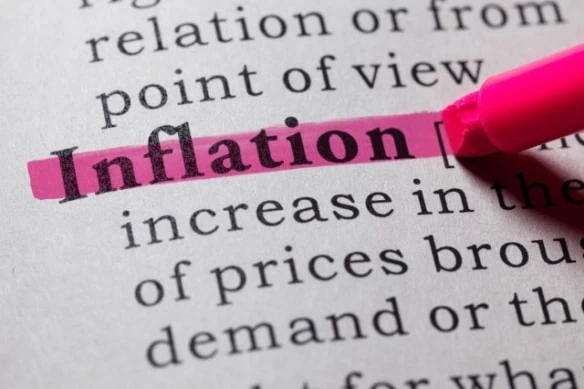Wall Street received a welcome surprise on Wednesday, as a bevy of data from May’s consumer price index (CPI) release showed easing inflationary pressures—a sign to many that the Federal Reserve will indeed cut back on its benchmark interest rate at some point in 2024.

The U.S. Department of Labor said on Wednesday that May’s consumer price index, which measures the change in prices on a variety of consumer goods and services, was flat compared to April on a seasonally adjusted basis. That was below the 0.1% increase expected by Dow Jones-polled economists, and the lowest month-over-month reading since May 2020.
A 3.3% year-over-year increase in inflation was also below expectations; economists were expecting prices to rise by 3.4%.
Related: The 13 Best Mutual Funds You Can Buy
“Core” CPI—a measurement that backs out food and energy costs, which are more volatile than the other costs tracked by the Labor Department—also came in lower than expected, at +0.2% versus projections for +0.3%. The core print was the smallest month-over-month increase since August 2021. Year-over-year, core CPI came in up 3.4%, below expectations for an increase of 3.5%.
Here’s a quick look at May’s key CPI figures:
- MoM CPI: Flat (vs. +0.1% est.)
- YoY CPI: +3.3% (vs. +3.4% est.)
- MoM Core CPI: +0.2% (vs. +0.3% est.)
- YoY Core CPI: +3.4% (vs. +3.5% est.)
Among May’s most noteworthy gains was continued stickiness in shelter costs, which were up 0.4% MoM and 5.4% YoY. Food away from home grew 0.4% MoM and 4.0% YoY. Used car and truck prices were up 0.6% month-over-month, but still remained more than 9% lower than at this point a year ago.
Energy was a big source of relief, off 2% month-over-month, including a 3.6% decline in gasoline. New vehicle prices were off 0.5%, transportation services were 0.5% lower, and apparel prices were down 0.3%.
Related: 9 Monthly Dividend Stocks for Frequent, Regular Income
“After firing hot for the last few years, it appears the inflation engine is starting to cool off,” says Jason Pride, Chief of Investment Strategy & Research at Glenmede. “The heart of the issue on sticky inflation has been core services prices, which after setting up shop in the stratosphere now seem to be coming back down to earth. Core services excluding the impacts of shelter was flat for May, offering a moment of reprieve after stubbornly staying hot for several months in a row.”
Broadly, but hardly unanimously, experts cited Wednesday’s report as enough reason for the Federal Reserve to start cutting back on interest rates later this year.
“May CPI was softer than expected across headline and core readings, indicating the disinflation process is playing out,” says Sonu Varghese, Global Macro Strategist at Carson Group. “This keeps the Fed on track for cuts in 2024, with the first cut likely coming in September, especially with the unemployment rate at 4% and risk of going higher.”
More Pros’ Takes on May CPI
Here, we outline more thoughts from the experts on what May’s CPI numbers mean for consumers, markets, the Federal Reserve’s future actions, and more:
“The downside surprise to price growth is a fly in the ointment for FOMC members, shaking their resolve to signal slower rate cuts in today’s dot plot of interest rate predictions. Markets will flip back to pricing two or more cuts for 2024, but repeated flip-flopping of expectations has weakened their sway on stocks. Investors will start to think about the demand implications of slower price growth, questioning whether last week’s employment data was more of an anomaly than a harbinger of continued robust consumption. This puts the onus of supporting earnings growth even more squarely on large-cap tech and their heroic AI investments.”
—Peter Graf, Chief Investment Officer, Nikko Asset Management Americas
“Today’s soft CPI puts the Fed back in the driver’s seat to steer towards a precautionary cut later this year to ensure recession remains remote. However, at this stage, there is no greater goal than Fed credibility to keep inflation expectations anchored, economic activity robust and financial markets friendly. Until greater dis-inflation evidence is seen both in breadth and depth, today’s softness is supportive of a preemptive cut rather than a pivot in Fed policy towards accommodation.”
—Ashwin Alankar, Head of Global Asset Allocation, Janus Henderson Investors
The Best Dividend Stocks: 10 Pro-Grade Income Picks
“The bottom line for the Fed is that the report supports their (and our) narrative that 1Q inflation data was as much noise as signal and inflation should remain in a downward trend. The report fits our view of today’s FOMC, where we expect Powell to remain confident that a supply shock, cooling demand, and modestly restrictive policy will keep inflation trending lower and the Fed biased to cuts. We retain our outlook for the Fed to start its cutting cycle in December.
“While we do not see a September Fed cut as likely, market pricing is a little more optimistic. The print gives market conviction in Fed cuts and faster pace of disinflation; it also justifies our bias to trade the recent 10-year range from the long side.”
—BofA Securities economists
“Inflation came in lower than expected and is stabilizing now at eight straight months with CPI at or below 3.5%. The move is not enough for the Fed to believe that inflation is clearly moving toward its target, and there is little reason to think they cut rates in the coming months. The Fed will likely cut rates when either inflation is clearly moving toward 2% or economic growth slows; neither of those is supported by the data. Inflation is cooling, but not rapidly with one-year inflation expectations still above 3%.”
—Scott Helfstein, SVP, Head of Investment Strategy, Global X
“Today’s CPI report was the sort of news the Fed has been anxiously waiting for since beginning its tightening program in 2022. Attention will now shift to the FOMC’s updated dot plot to be published this afternoon and policymakers had the flexibility to revise their projections until this morning. Altogether, this report probably shifts the focus back to two or three rate cuts in 2024.”
—Jason Pride, Chief of Investment Strategy & Research, Glenmede
“It would take an extremely soft CPI print to change the course of the Fed in July after a strong payroll report last week. We squarely believe today is a no-go meeting and the CPI number was not weak enough to change our view on July’s meeting. While September may be on the table, today would have had to be the first of a handful of inflation data prints that went right, which it did. It does remain challenging, however, for inflation to cool with the backdrop of the summer’s heat. Let’s see what the Fed forecasts this afternoon. This is good news, but we will need more of it.”
—Lindsay Rosner, Head of Multi-Sector Investing, Goldman Sachs Asset Management







